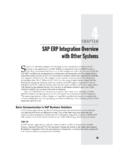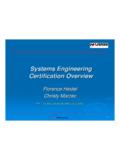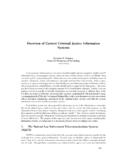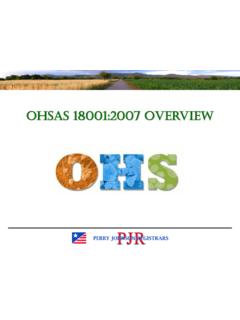Transcription of Systems Integration Overview
1 White Paper Systems Integration Overview Introduction Systems Integration is a process whereby a cohesive system is created from components that were not specifically designed to work together. Components of an integrated system are often Systems in their own right. This paper discusses Systems Integration in terms related to the building management industry but many of the concepts and caveats are equally applicable to other industries. A building management project frequently requires the Integration of separate specialized Systems , controllers, and infrastructure technology into a building management system . The requirement for Integration can arise for a number of reasons. Some of those are: Another vendor s specialized controller must be added to a system . For example, add a boiler controller to the building automation system . Two buildings of a campus may have Systems from different vendors. The owner requires the two Systems to be managed from a single seat.
2 In other words, a single operator sitting in front of a single workstation must be able to operate all the Systems . Several stand-alone building Systems must be integrated into a single facility management system in order to enable automatic responses to events. For example, swiping a badge on the security system card reader must turn on lights and HVAC for an office floor. The facility owner s expectation is for the Integration to be cost-effective and the result to be a single cohesive system . Use this document to help understand some of the decisions that must be made when designing an integrated system . Key Concepts ASCII The American Standard Code for Information Interchange (ASCII) is a widely used data format for the representation of English and Western European text characters. API An Application Programming Interface (API) is a defined and documented software interface that a software program may use to interact with a system or a specific sub- system or feature of a system .
3 The OPC Data Access and OPC Alarms and Events APIs (defined by the OPC Foundation) are examples. White Paper: Integration Basics AFDtek, a division of Fastek International Inc. | 2 Integration Integration is the process of inter-connecting one system with another system in order to provide a useful exchange of information, data and/or control between the Systems . Interface An interface is a point where interaction occurs between two Systems , devices, programs, etc. To be useful for Integration , an interface must have stable and well-defined characteristics. A standard interface is one that is defined and documented by a recognized professional or industry organization. The RS-232 interface is an example of a standard hardware interface it is currently managed by the Telecommunications Industry Association (TIA). The term interface is also used to refer to a hardware or software component that translates or converts from one interface to another interface.
4 Media Media is the medium through which data is conveyed. Media has specific physical properties such as voltage levels, bandwidth and frequency response. A telephone line is a type of media characterized only by its physical properties. More complex media may provide a choice of cabling or interconnections with different sets of physical properties. For example, standard available Ethernet media includes several specifications for twisted pair wire and fiber optics cables. The common element among these various types of physical media is the Media Access Control (MAC) protocol. A MAC protocol manages access to the media for outgoing messages and manages address recognition of received messages. A MAC protocol is an integral component of the implementation of sophisticated media such as Ethernet. When integrating separate devices, determining and achieving a common media is one of the steps to a successful Integration . For popular media such as Ethernet, products are available that convert from one type of physical media to another.
5 Middleware Middleware is software used to glue together disparate Systems without those Systems needing to know anything about each other. Knowledge of both Systems is contained in the middleware. Protocol A protocol is a set of rules governing the exchange or transmission of data electronically between devices. A protocol is like a language; both devices must understand the same language in order to exchange data. A complex system has multiple levels of interactions. The different levels will likely use different protocols, each optimized for the nature of the interactions required at that level. For example, the network level might interact using Ethernet. The operating Systems might interact using TCP/IP. The application programs might interact using OPC. system A system is a group of hardware and software components that work together in a cohesive manner to perform a task. A system may be as simple as a single controller or as complex as the telephone network.
6 A personal computer with a video card, memory, a disk drive and an operating system is also a system . White Paper: Integration Basics AFDtek, a division of Fastek International Inc. | 3 system Integration system Integration is a process whereby a cohesive system is created from components that were not specifically designed to work together. Components of an integrated system are often Systems in their own right. Integration Rules of Thumb A successful Integration is one that meets the system owner s needs in the most cost effective way. Generally, the most cost effective Integration is achieved by making use of existing capabilities of the Systems involved. Performing system Integration can be a complex and costly process. Before proceeding with system Integration , be certain it is necessary. The most cost effective Integration is no Integration . Begin a system Integration project by evaluating the requirements for Integration .
7 Integration requirements are often open-ended or ambiguous. Project specification documents often state that Integration is required between two Systems , but provide no other details. Assess the project s requirements: Do not make up detailed requirements based on your assumptions require specification details be provided Understand the intent of the people responsible for the specifications Understand the needs of the operational people these may not agree with the specification Make sure the interested parties resolve their differences Before proceeding, be sure Integration is the most effective way to meet the needs of the clients If Integration is required, understand the scope of Integration that is needed. A cost effective Integration will use the simplest and most direct approach that meets the objectives of the Integration . For example: If the requirement is to have single-seat display of alarm messages, a suitable solution may be as simple as using a commercial terminal emulation program on the primary workstation, connected to the secondary system , as the display window for alarms from the secondary system If the requirement is to be able to manage two or more Systems from a single-seat, simply running the workstation software of two different Systems concurrently on the same computer may be a suitable solution If the requirement is to integrate the display of data from different Systems , Integration through the workstation may be more practical than a controller level solution If full data exchange between the Systems is required and only a custom solution can achieve it.
8 A workstation based solution may be more cost effective than a controller level solution Seek a solution that makes use of the built-in capabilities of the Systems involved and/or uses off-the-shelf alternatives that can meet the requirements. For example: When providing controllers to perform specialized functions, select controllers that work with protocols already supported When requirements specify controllers that are not compatible with supported protocols, look for and propose alternatives that work with a supported protocol White Paper: Integration Basics AFDtek, a division of Fastek International Inc. | 4 When non-compatible Systems must be integrated, look for commercially available gateway products that can connect the Systems together When requirements specify integrating data at the workstation, look first for commercially available workstation software products such as communications drivers, OPC servers and middleware that may facilitate the Integration A solution that requires custom hardware or software should be a last resort.
9 A custom solution brings the following issues: The implementation cost is high; it may not be cost effective within the budget of the project The cost of system maintenance is increased; changes or updates made to the integrated Systems may require updates to the custom solution Limited warranties and support Unproven solutions have an increased risk of failure Maintenance may be difficult to arrange Finally, know when your own experience is not sufficient and seek outside expertise. Conclusion Systems Integration is a complex topic with many factors to consider. Execution of a successful Integration will require knowledge and understanding of the requirements weighed against a careful balance of compromises.








